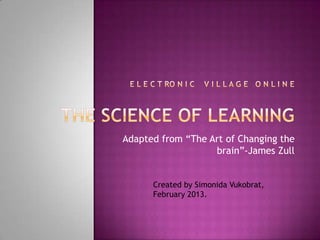
Emotions and thinking
- 1. Adapted from “The Art of Changing the brain”-James Zull Created by Simonida Vukobrat, February 2013.
- 2. According to James Zull, teaching is the art of changing the brain. Successful teachers produce change in a learner’s brain. Generating that change is not a science; it’s an art. Science may tell us what learning is, and what influences it, but to apply this knowledge effectively is an art!
- 3. The brain carries out four basic functions: getting information = 1. gathering (sensory cortex), 2. analyzing (back integrative cortex) - making meaning of information 3. creating - creating new ideas from these meanings (front integrative cortex), 4. Acting - acting on those ideas (motor cortex). If we ask our students to do these four things, they will have a chance to use their whole brain.
- 4. Feelings are both created and perceived by the brain. They directly influence our behaviors and attitudes and determine whether or not students are motivated to learn. The emotion centers of the brain are strongly connected to the thinking areas. Emotion and thought are physically entangled!
- 5. The teacher must find ways in which learning itself is intrinsically rewarding. Learning itself must evoke emotion, and must relate to things that naturally engage the learner. Extrinsic motivators, such as grades or gold stars, are only needed when these intrinsic conditions are not met. If learners are given tasks that connect with things which naturally interest them, if they find learning rewarding, and if they make progress, extrinsic rewards are not needed.
- 6. Helping students find connections with their past beliefs and experiences is vital for learning. Knowledge grows as our neurons make new connections, and as they increase or decrease the strength of existing neuronal networks in the brain. Information enters the brain through existing networks of neurons which is one’s prior knowledge. Learning is constructing knowledge and that process modifies the old. Sometimes the old networks are so powerful that they become a barrier to new knowledge – proactive inhibition.
- 7. 1. The art of discovery of existing networks. This means understanding our students The better we understand how students think and the nature of their prior experiences, the better insight we can have with regard to how they can build on their existing neuronal connections. 2. The second aspect is the skill of building on existing connections, even when they seem wrong.
- 8. a) The first one is practice. Neurons that fire a lot tend to form more connections and strengthen new connections. For example, neurons have the ability to just stop firing when the stimulus turns out to be unimportant (habituation). Repeating isn’t necessarily enough b) The other thing that helps neuron networks become stronger, larger and more complex is emotion. There are studies which show that such changes in networks can be generated simply by triggering neurons to dump “emotion chemicals” - adrenaline, serotonin and dopamine - on the firing networks. These chemicals are delivered to specific parts of the brain by specific neuron pathways. Thus, the concomitant frequent firing and exposure to the chemicals of emotion lead to great change in neuronal networks
- 9. Practice and meaning are important parts of the art of changing the brain. The student will not practice in a meaningful way unless he/she cares. Ultimately it’s the learner who is in control. The teacher’s role is to arrange conditions and challenges in ways that engage the learner.
- 10. Teachers often complain that their students aren’t motivated, as though it were some sort of character flaw. They would learn if they would just get motivated. People cannot stay motivated enough to learn unless they experience some success. They may be motivated to try something, but if they are going to sustain motivation, they must sense some progress. It’s the teacher’s job to find a pathway to success. We shouldn’t ask “How can I motivate my students?” but rather “How can I support their learning?”. They will be motivated if they are learning, because learning is rewarding to the brain. This motivation is intrinsic and it is unrelated to any external reward or punishment. It is the teacher’s most powerful ally.
- 11. The human brain is a learning organ; learning is what it does. The main task for the teacher is to help the learners find connections. Once students encounter elements that connect with their life, their emotions, their experiences or their understandings, they will learn. Their brains will change. Learners must create their own ideas and act on them if they are to take ownership of their learning. The learner must evaluate his work in order to own it. If it is truly his, it must be formed in a cycle of creating, evaluating, re-creating and reevaluating. The learner is the one who has to be in control.
- 12. We teach students. Teaching is about the students. A teacher is most successful when his/her students can say: “We did this ourselves.” This is an emotional claim. Success in learning is emotional success. No matter how much the teacher appreciates the learning cycle or neuronal networks, a teacher has little hope of meaningful academic connection if his/her learners don’t feel engaged.
- 13. The fear region in the brain is the amygdala. Our amygdala is constantly monitoring our experience to assess current emotional standing. When we want to help someone learn, we should be aware that our learner will be quickly and subconsciously monitoring the situation through the amygdala. This isn’t something the learner decides to do. It just happens. When the amygdala senses danger, it subconsciously sends signals directly out to the body.
